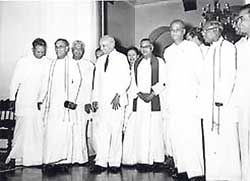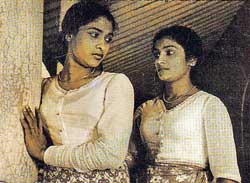A momentous general election
 |
| Prime Minister S. W. R. D. Bandaranaike with the Governor General Sir Oliver Goonetilleke and members of the Cabinet after the swearing in ceremony at Queen's House on April 12, 1956. |
What turned out to be a momentous parliamentary general election in the early years of Independent Sri Lanka was completed on April 10, 1956. Those were the days when a general election was held over a number of days. The first election in 1947 was held over 19 days during August/September and lasted nearly a month. The second election in May 1952 was held over four days and the third in April 1956 was reduced to three days.
The United National Party (UNP) won comfortable majorities in the first two general elections. In the 1947 election, the UNP won 42 seats and the next brought them a landslide victory winning 54 out of 95. By the time the third general election was held, S. W. R. D. Bandaranaike who was Leader of the House in the UNP government and had left the party in July 1951, organised himself forming the Mahajana Eksath Peramuna (MEP) with several opposition parties and reaching a no contest pact with others.
The 1956 election saw the recognition of the political party system allocating a separate symbol for each party. Five parties were recognised: Ceylon Communist Party (Symbol – Star), Federal Party (House), Lanka Sama Samaja Party (Key), Mahajana Eksath Peramuna (Hand) & UNP (Elephant). Candidates who contested as independents could select symbols from a list prepared by the Elections Department. In the two earlier elections, the candidates selected their own symbols.
Elections were held on three days – April 3, 5 & 10. On the first day itself it became obvious that the Mahajana Eksath Peramuna would win when the party secured 27 of the 36 seats contested. The UNP captured just eight seats which, in fact, were the only ones the party won at the election. At the end of the third day MEP had registered a landslide victory winning 51 of the 60 seats contested and reducing the governing party to a mere eight seats registering a loss of 52 seats held in the previous Parliament. Only the Prime Minister (Sir John Kotelawela) and one minister (M. D. Banda) were returned. The remaining ten ministers lost their seats.
MEP leader S. W. R. D. Bandaranaike won the Attanagalla seat with the highest majority (41,997) polling 45,016 votes while his two opponents collected only 3,640 votes. Of the 51 MEP members returned, 43 were members of the Sri Lanka Freedom Party (SLFP) which Bandaranaike founded after leaving the UNP.
A silent revolution had taken place. A party which in effect been in power for nearly 25 years since the establishment of the Donoughmore Constitution in 1931 had been overthrown. Drastic changes in both foreign and domestic policies were to take place in keeping with the MEP manifesto.
With the resignation of Prime Minister Sir John Kotelawela on April 11, Bandaranaike was invited to form the government. He was sworn in as Prime Minister on April 12.
|


